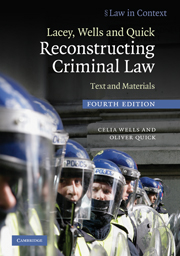Book contents
- Frontmatter
- Contents
- Preface
- Table of cases
- Table of statutes
- Section I Approaching Criminal Law
- Section II Law, Order and Security
- 4 Social and Political Constructions of Disorder
- 5 Securing Order
- 6 Public Order
- 7 Criminal Law and Justice
- Section III Interpersonal Violence; Drugs and Alcohol Abuse; Offence Preparation and Participation
- Section IV Property and Propriety
- Section V Regulating Sexuality and Bodily autonomy
- Section VI Making a Killing
- Bibliography
- Index
4 - Social and Political Constructions of Disorder
from Section II - Law, Order and Security
Published online by Cambridge University Press: 05 June 2012
- Frontmatter
- Contents
- Preface
- Table of cases
- Table of statutes
- Section I Approaching Criminal Law
- Section II Law, Order and Security
- 4 Social and Political Constructions of Disorder
- 5 Securing Order
- 6 Public Order
- 7 Criminal Law and Justice
- Section III Interpersonal Violence; Drugs and Alcohol Abuse; Offence Preparation and Participation
- Section IV Property and Propriety
- Section V Regulating Sexuality and Bodily autonomy
- Section VI Making a Killing
- Bibliography
- Index
Summary
Over the next two linked Sections we examine a broad range of offences and principles. In this Section, ‘Law, order and security’, we look first at the concept of public order, followed in Chapter 5 by an examination of the trend towards preventive security-based justice, and then in Chapter 6 we explore the different ways that law attempts to control public order. We conclude with a thematic summary placing public order in the context of criminal law and the criminal process. In Section III we move to a focus on interpersonal violence, before investigating the regulation of drugs and alcohol, the abuse of which underlies much of the regulated behaviour we discuss in these Sections. We end with an account of the different modes of liability that widen the net of criminal enforcement beyond the limits of substantive offences. These are the inchoate offences of attempt, conspiracy and assisting and encouraging crime, and secondary liability (aiding and abetting). All of these, with the exception of attempt, are ways of casting criminal liability beyond the individual offender.
Why public order law? The offences of affray, violent disorder and causing alarm (Public Order Act 1986, ss. 2–5) are as familiar to the police (and courts) as the assault and injury offences under the Offences Against the Person Act 1861 that are discussed at length in all criminal law texts.
- Type
- Chapter
- Information
- Lacey, Wells and Quick Reconstructing Criminal LawText and Materials, pp. 129 - 143Publisher: Cambridge University PressPrint publication year: 2010



